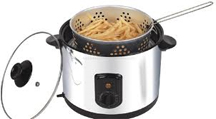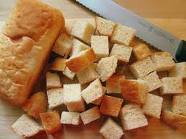Some Skinny on FAT
By Alice Osborne
 By now we are pretty familiar with the advice: For better health, choose oils/fats that are low in saturated fat. But what are those?
By now we are pretty familiar with the advice: For better health, choose oils/fats that are low in saturated fat. But what are those?
Canola oil (also given the unfortunate name rapeseed oil, and sold under the brand name Puritan) is the oil lowest in saturated fat. Also, canola oil is the highest in omega-3 fatty acids.
 But, this doesn’t mean that Canola oil is the be-all and end-all for our cooking. For instance, most experts recommend using peanut oil for high temperature cooking, canola oil or olive oil for medium temperature cooking, and a variety of polyunsaturated oils for baked goods. In a way, there is no “healthiest oil” since each oil can offer different benefits and one may be a better choice than another, depending on what we intend do to with it.
But, this doesn’t mean that Canola oil is the be-all and end-all for our cooking. For instance, most experts recommend using peanut oil for high temperature cooking, canola oil or olive oil for medium temperature cooking, and a variety of polyunsaturated oils for baked goods. In a way, there is no “healthiest oil” since each oil can offer different benefits and one may be a better choice than another, depending on what we intend do to with it.
One thing medical and diet experts do agree on is that we need fat in our diet because of the essential fatty acids factor. Essential fatty acids are vital for good health. Without some fats in our diets, we cannot absorb the fat-soluble vitamins A, D, E and K.
 Now, let’s change the subject slightly - from health to use - specifically deep frying. You probably know that cooking oil used for deep-frying can usually be reused several times. We just need to wait until the oil has cooled completely before handling, then it should be strained into a clean sealable container for storing. I like to date the container; if stored too long, oil goes rancid, even in the fridge.
Now, let’s change the subject slightly - from health to use - specifically deep frying. You probably know that cooking oil used for deep-frying can usually be reused several times. We just need to wait until the oil has cooled completely before handling, then it should be strained into a clean sealable container for storing. I like to date the container; if stored too long, oil goes rancid, even in the fridge.
 The most accurate method of testing the temperature of oil for deep-frying is a deep-fat thermometer. Make sure the bulb of your thermometer is completely immersed in the oil, but not touching the bottom of the pan. Otherwise, the reading could be affected. If a deep-fat thermometer is not available, the age-old method of dropping a square of bread into the hot oil will work. If the bread cube rises to the surface crackling and frying, the oil's hot enough.
The most accurate method of testing the temperature of oil for deep-frying is a deep-fat thermometer. Make sure the bulb of your thermometer is completely immersed in the oil, but not touching the bottom of the pan. Otherwise, the reading could be affected. If a deep-fat thermometer is not available, the age-old method of dropping a square of bread into the hot oil will work. If the bread cube rises to the surface crackling and frying, the oil's hot enough.
 Rule of thumb when using this method - If the bread cube browns uniformly in:
Rule of thumb when using this method - If the bread cube browns uniformly in:
60 seconds, the temperature is 350-365°F
40 seconds, the temperature is about 365-382°F
20 seconds, the temperature is about 382-390°F
To dispose of used cooking oil, carefully pour cooled oil into a strong sealable container, such as an old plastic jar with a lid or old coffee can. (Avoid using breakable glass jars.) If the amount of oil is small, place the filled, sealed jar in the trash. Dispose of large amounts of cooking oil by taking it to the local landfill.
Do not pour cooking oil down the kitchen drain. Even small amounts will eventually clog the plumbing. Remember to always wait until cooking oil has cooled completely before handling.

Contribute to the Cook'n Club!
DVO would love to publish your article, prose, photography and art as well as your cooking, kitchen and nutrition tips, tricks and secrets. Visit the Newsletter Submission / Win Win for All section in our Forum for more information and details.
